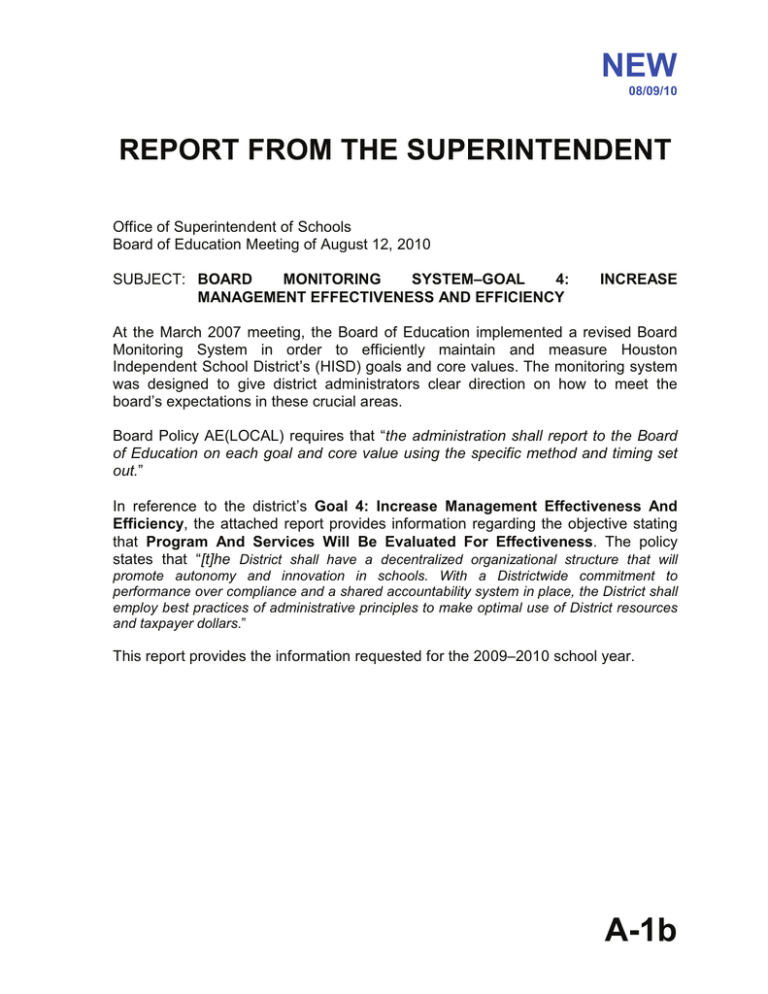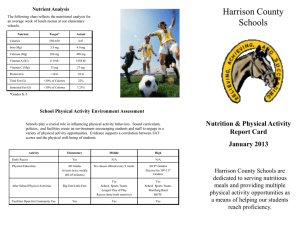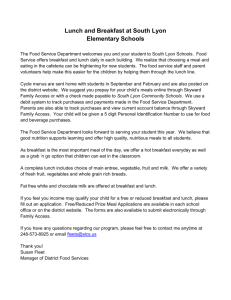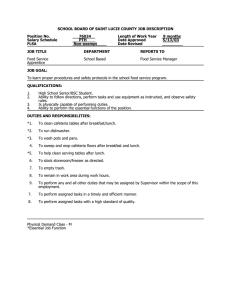NEW REPORT FROM THE SUPERINTENDENT
advertisement

NEW 08/09/10 REPORT FROM THE SUPERINTENDENT Office of Superintendent of Schools Board of Education Meeting of August 12, 2010 SUBJECT: BOARD MONITORING SYSTEM–GOAL 4: MANAGEMENT EFFECTIVENESS AND EFFICIENCY INCREASE At the March 2007 meeting, the Board of Education implemented a revised Board Monitoring System in order to efficiently maintain and measure Houston Independent School District’s (HISD) goals and core values. The monitoring system was designed to give district administrators clear direction on how to meet the board’s expectations in these crucial areas. Board Policy AE(LOCAL) requires that “the administration shall report to the Board of Education on each goal and core value using the specific method and timing set out.” In reference to the district’s Goal 4: Increase Management Effectiveness And Efficiency, the attached report provides information regarding the objective stating that Program And Services Will Be Evaluated For Effectiveness. The policy states that “[t]he District shall have a decentralized organizational structure that will promote autonomy and innovation in schools. With a Districtwide commitment to performance over compliance and a shared accountability system in place, the District shall employ best practices of administrative principles to make optimal use of District resources and taxpayer dollars.” This report provides the information requested for the 2009–2010 school year. A-1b NEW Attachment A-1b Board Monitoring System: Goal 4 DEPARTMENT SUMMARY As part of the Houston Independent School District (HISD) Board Monitoring System, the HISD Board of Trustees has requested periodic reviews of administrative systems within the district. Therefore, in addition to the monthly A-1 Status Report, Food Services has also provided a department overview including the following: 1. Areas of Responsibility…………………………………………………………………………..2 2. Fast Facts / Scope of Services………………………………………………………………....2 3. Key Performance Indicators…………………………………………………………………….3 4. 2009–2010 Key Accomplishments……………………………………………………………3-4 5. 2010–2011 Major Initiatives …………………………………………………………………...5 6. Program Evaluations and Audits……………………………………………………………….6 7. Figure 1: Organizational Chart………………………………………………………………...8 8. Figure 2: Performance Management Scorecard………………………………………...…..9 9. Table 1: Schedule of Revenues, Expenditures, and Changes in Fund Net Assets……...13 10. Nutrition Transition of Menus……………………………………………………………..…...14 11. Monthly Status Report……………………………………………………………..……….…..16 Major Projects—Food Services/ARAMARK August 2010 1 Food Services Mission: HISD Food Services, in partnership with ARAMARK Education, is dedicated to serving quality, nutritious meals to students everyday. Food Services knows the value of nutrition in assuring young scholars achieve peak academic performance. It is the department’s commitment to provide great tasting, healthful meals to ensure the students are better equipped to be successful in the classroom. Food Services entire team is committed to supporting achievement through proper nutrition by operating a premier food service program. Each team member is dedicated to service, driven by quality, and devoted to the community. Areas of Responsibility 1. Sub-Departments Reporting to Executive General Manager x Human Resources x Information Technology – Automated Data Collection, SAP systems, Cybersoft Point-ofSale and Production planning, PeopleSoft integration x Student Eligibility and Accountability – Free and Reduced-price meal applications x Finance x Communications/Marketing x Operations – Campus-based x Production – Culinary, Nutrition, Production Areas x Warehouse and Distribution x Maintenance – Campus Kitchens and Food Service Support Facility (FSSF) 2. Sub-Departments – Reporting to Office of Business Operations x Quality Assurance (FSSF quality and food safety) x Quality Control (campus based food and kitchen safety, compliance reviews) 3. Services Provided: • Breakfast – Traditional Cafeteria Service and First Class Breakfast – 13 million meals • Lunch Program – 23 million meals • Summer Meals Program - 1.8 million meals • After-school Snacks • Saturday Tutorial Meals • Full Service Catering • Nutrition and Wellness Awareness - Dietetic Intern Program, Student and Parent Wellness Engagement Committees - Mobile Dairy Cow Show, Student Tours, Nutrition Mascot, Garden Connection Fast Facts / Scope of Services • • • • • Total Employees – 1,807 - Management, Grade 25 and above – 77 (Figure 1—p. 8) - Production, Administration, Maintenance and Warehouse/Transportation – 233 - Field Employees – Team Leads and Food Service Attendants – 1,497 21 ARAMARK positions 284 buildings/kitchens 240,000 meals served per day (as of May 2010) 79 percent of enrollment eligible for free or reduced meal status Major Projects—Food Services/ARAMARK August 2010 2 • • A la carte revenue $32,000 per day $ 111 million budget - $52.9 million supplies and materials - $43.6 million payroll - $14.5 million direct costs and utilities Key Performance Indicators 2010–2011 Proposed Food Services Performance Management Scorecard (Figure 2—p. 8) • Together with ASPIRE and district leadership, the Food Services department compiled numerous metrics in the Performance Management Scorecard that will be measured monthly, quarterly, and annually. • During the 2009–2010 school year, the Food Services department began conducting a monthly BLAST (Building Leaders and Strong Teams) meeting, which reviews and discusses the results of all metrics. This meeting includes 45 members of the Food Services management team. 2009–2010 Key Accomplishments • Developed and implemented First Class Breakfast Expansion program: - Developed proven delivery methods and menu options allowing First Class Breakfast expansion to all elementary schools during February through May 2010 - Over 130 campuses implemented this innovative program designed to boost student achievement through proper nutrition. Campuses showed remarkable results. The number of students eating school breakfast at those campuses increased from 39 percent to 81 percent of enrollment– an average of 274 students per campus. Breakfast Participation Rate 50% 45% 40% 35% 30% 25% 20% 15% 10% 5% 0% AUG SEP OCT NOV DEC JAN FEB MAR APR MAY 2008-2009 28.0% 28.5% 32.9% 35.2% 32.9% 33.5% 33.8% 33.3% 34.3% 32.5% 2009-2010 29.2% 33.1% 33.1% 34.8% 33.1% 35.0% 38.0% 41.7% 47.6% 50.3% GOAL 29.4% 28.7% 32.6% 37.7% 34.7% 33.3% 33.3% 32.7% 33.4% 31.2% Major Projects—Food Services/ARAMARK August 2010 3 - Noticeable increases of one percent to 2.5 percent were observed in the lunch participation rate beginning in the month of February, directly correlating with the rollout of First Class Breakfast. Lunch Participation Rate 70% 60% 50% 40% 30% 20% 10% 0% • • • • • • • • • AUG SEP OCT NOV DEC JAN FEB MAR APR MAY 2008-2009 60.3% 59.2% 67.4% 66.1% 63.6% 65.0% 65.0% 65.5% 65.9% 61.9% 2009-2010 63.2% 64.7% 65.6% 65.8% 63.6% 66.6% 67.2% 67.3% 68.0% 63.3% GOAL 66.7% 65.7% 68.1% 68.6% 66.0% 68.3% 68.3% 67.6% 68.4% 61.1% Established Food Services Parent Advisory Committee to provide insight to ensure student preferences and optimal healthy menus goals are established and met Engaged parents and the professional community in developing an active and comprehensive food services wellness and nutritional strategic plan Incorporated compliance focus in all training activities leading to successfully passing the United States Department of Agriculture/Texas Department of Agriculture (USDA/TDA) Coordinated Review Effort (major program compliance audit) with no financial penalties or revisit mandate Moved department from manual time reporting to more efficient automated time clock Implemented additional modules to Food Services’ comprehensive Point-of-Sale system that integrated food production recordkeeping and menu planning, with increased efficiencies and services Increased utilization and delivery of FSSF production products to all campuses Developed and implemented a specialized Automated Data Collection system allowing effective management and tracking of over $40 million of food and supplies in more than 285 locations Increased meal application processing speed and accuracy by providing a convenient online processing method for district parents Incorporated campus-based flexible-time positions to match operational needs of the new facility-focused production model 2010–2011 Major Initiatives Major Projects—Food Services/ARAMARK August 2010 4 • • • • • • Revitalize participation drive for free and reduced-price meal applications by promoting on-line applications and attending school registrations and community health fairs Introduce a new comprehensive interactive training program for Team Leads (cafeteria managers) Renovate 15 low-performing cafeterias with new dining concept solutions to drive participation Reintroduce student sampling and focus groups throughout secondary campuses Continue Food Services Parent Advisory committee activities and public awareness initiatives Continue Food Service Support Facility Optimization Plan to expand product line Goals for Food Service Support Facility Utilization FSSF Utilization Targets First Class Breakfast All Lunch Year 1 Year 2 Year 3 August 2010 – July 2011 70% Breakfast Entrées 10% Breakfast Sides 35% Lunch Entrées August 2011 – July 2012 80% Breakfast Entrées 20% Breakfast Sides 25% Lunch Sides 33% Lunch Sides 10% 30% August 2012 – July 2013 90% Breakfast Entrées 20% Breakfast Sides 55% Lunch Entrées 35% Lunch Sides 100% After School Snack Program A la Carte Community / Outside Sales Major Projects—Food Services/ARAMARK August 2010 45% Lunch Entrées 20% of items To be determined 30% of items To be determined 5 • • • • Implement First Class Breakfast expansion program in all middle schools - By October 30, 2010, all remaining elementary and middle schools will be implemented - In October 2010, First Class Breakfast will be served to more than 117,000 students at over 200 campuses each day across HISD. Focus on Food Safety compliance training and accountability Update HISD Food Services website to include nutritional analysis information for breakfast and lunch Revamp menu to achieve improved cost/nutrition balance (Table 2—p.14) Program Evaluations and Audits • • • • • USDA/TDA Coordinated Review Effort A review was performed in February 2010. HISD passed with no financial penalties or mandated revisit TDA Summer Food Service Program Administrative Review - Reviews were performed in 2008 and 2009. HISD passed without corrective action needed or financial penalties - A review was performed in 2010. HISD passed with no financial penalties ARAMARK Financial Audits – Results from audits performed in 2008 and 2009 confirm no major violations City of Houston Health Department Inspections – Two city health inspections were performed per campus in 2008, 2009, and 2010, No major violations were reported School Principal Customer Service Surveys – Principal surveys are performed each year. - 2008 – Average response scoring ranged from 4.47 – 4.79 out of five possible points. - 2009 – Average response scoring ranged from 4.36 – 4.67 out of five possible points. Major Projects—Food Services/ARAMARK August 2010 6 Figure 1: Food Services Organizational Chart Depicts all sub-department reporting structure for grade level 25 and above Major Projects—Food Services/ARAMARK August 2010 7 Figure 2: 2010-11 Proposed Food Services Performance Management Scorecard Food Services - 2010-2011 Performance Management Scorecard Board Goal: Develop Human Capital CRITICAL OUTCOME: Staff Quality: attract and retain a high-quality workforce by providing a positvie work climate and ongoing support and training. OBJECTIVE: ensure staff are qulified, engaged and motivated. Results Actual Target Staff attendance rate % of employees that participated in training % of employees who are City of Houston certified # of days to fill vacant position after posting by Human Resources 20 Board Goal: Provide a Safe Environment CRITICAL OUTCOME: Safety and security provide every student, employee, visitor and volunteer of the school distrctict security and safety from violence, criminal, or vadalistic acts on every school cmpus and facility. OBJECTIVE: Provide safe meals. Results Actual Target % of campuses recieiving two required site visits by City of Houston health inspectors # of schools that are red-tagged 100 % % of campuses receiving two documented site visits by internal Quality Control department associates # of schools providing food items outside of the National School Lunch Program without the City of Houston food service permits 100% 0% 0 Board Goal: Increase Management Efficiency Major Projects—Food Services/ARAMARK August 2010 8 CRITICAL OUTCOME: Compliance: Establish systems and processes that ensure complaince with all state, federal, and legal regualtory requirements. OBJECTIVE: ensure compliance to all regualtions and policies Results Actual Target % of site reviews completed by Area Managers by February 2011 Internal snack audits completed within four weeks of implementation to comply with TDA requirements 100 % % of bi-monthly food inventory completed and reviewed within three days of deadline 95% 100% CRITICAL OUTCOME: Financial Responsibility: Maximize the use of taxpayer dollars by purchasing at most cost effective levels, reducing utility and operational cost by identifiyng and eliminating waste , and by assuring that all suppliers meet high standards. OBJECTIVE: improve cost efficiency and effictiveness Results % over/under budget Outstanding student meal balance Actual Target $ 100 K Total food services cost as percent of food service revenue 100% Food Servcies cost of goods as % of Food services revenue 39.5% Major Projects—Food Services/ARAMARK August 2010 9 CRITICAL OUTCOME: Effectiveness: Ensure ontime, accurate, non-instructional service delivery to schools and departments that is efficient and effective. OBJECTIVE: manage resources efficiently and effectively Results Actual Target Average meals per labor hour % of internal warehouse orders filled accurately 29 % of students submitting free, reduced-price, and paid meal applications 86.5% % of priority one technology remedy tickets completed within two days % of priority one maintenance work orders completed within 5.3 days 90% 95% 97% Board Goal: Create a Positive District Culture CRITICAL OUTCOME: Customer Service: Provide the highest level of service to our internal and external customers by creating processes to identify our customer’s expectations and then implement initiatives to meet those expectations. OBJECTIVE: Deliver quality customer service Results Actual Target Annual Principal Survey - support Annual Principal Survey - courtesy Annual Principal Survey – quality of knowledge Annual Principal Survey – responsiveness % students particpated in breakfast % students particpated in lunch Major Projects—Food Services/ARAMARK August 2010 55% 64.1% 10 % schools receiving good, very good, or excellent ratings on annual students surveys (30 schools) # of students reached by nutrition education (eg. Mobile Dairy Cow show, classroom lessons, health fairs, etc. Average number of monthly publications regarding Food Servcies to students, employees, parents, and other stakeholders Major Projects—Food Services/ARAMARK August 2010 75% 10K 15 11 Table 1: Schedule of Revenues, Expenditures, and Changes in Fund Net Assets HOUSTON INDEPENDENT SCHOOL DISTRICT SCHEDULE OF REVENUES, EXPENDITURES, AND CHANGES IN FUND NET ASSETS - FOOD SERVICE FUND FOR THE FISCAL YEAR ENDED JUNE 30, 2011 WITH COMPARATIVE DATA FOR PRIOR YEARS 2007-2008 Actual 2008-2009 Actual 2009-2010 Projected 2010-2011 Budget REVENUES: Food sales Miscellaneous local sources Total revenues 14,512,444 981,646 12,814,355 842,237 10,520,000 676,618 9,509,426 697,067 15,494,090 13,656,592 11,196,619 10,206,493 102,660,275 102,844,562 102,526,213 106,131,331 621,691 622,894 686,809 704,990 5,902,240 5,202,279 6,110,780 5,120,274 - - 109,184,206 108,669,735 109,323,802 111,956,595 334,691 10,319 2,572 3,049 66,742,268 4,460,139 4,447,518 625,151 68,037,995 5,036,012 4,376,793 619,644 78,305,150 4,866,474 6,075,998 590,245 93,132,243 5,249,621 4,358,584 587,439 76,609,767 78,080,763 89,840,438 103,330,936 EXPENDITURES Current Food services General administration Plant maintenance and operations Data processing services Total expenditures NONOPERATING REVENUES (EXPENSES) Earnings on investments Grants from federal agencies Child nutrition program Summer food program Donated Commodities State matching and other Total non-operating revenue 9,286,745 Transfer In/Out Change in net assets Total net assets, beginning (17,080,349) (16,932,380) (8,286,745) 1,580,834 34,759,344 17,678,995 746,615 1,746,615 1,746,615 3,327,449 Nutritional Transition of Menus Total net assets, ending Major Projects—Food Services/ARAMARK August 2010 17,678,995 746,615 12 2008-2010 HISD Menu Transformation x Increase whole grains at breakfast and lunch from average of one serving per week to daily offering of 100 percent whole grain products. o Spring 2008 – one whole grain per week between breakfast and lunch combined. o Spring 2009 – four to five servings per week at breakfast and five servings per week at lunch. o Spring 2010 – seven servings per week at breakfast and seven to eight servings per week at lunch. o Today, 69 percent of all grains served are whole grains (at least 51 percent of grain in the product is whole grain). x Increase offerings of dark green/orange fruits and vegetables from average 2.2 servings per week to three servings per week at lunch. o Today Food Services offers three servings per week, including broccoli (steamed, blends, and fresh), carrots (frozen, blends, and fresh), fresh oranges, and canned peaches. o Future Direction: incorporate more varieties of dark green vegetables x Increase offerings of legumes from average of 0.7 servings per week to one or more serving per week. o Today Food Services offers one serving per week of legumes. o Future Direction: incorporate more varieties of legumes x Increase fiber in menus from average of 6.9g/lunch and 3.6g/breakfast to seven to 11 grams per lunch and six to eight grams per breakfast. o Since spring 2008, Food Services has improved fiber at lunch to more than eight grams per day. o Since spring 2008, Food Services has improved fiber at breakfast to just under six grams per day (just under target). x Increase variety in fruits and vegetables offered daily. o Today Food Services is serving an average of 2.9 servings per week of fresh fruits and vegetables. o Food Services serves five different varieties of vegetables each week including broccoli, carrots, corn, green beans, and peas in various forms (fresh, frozen, and blends). o Since 2008, Food Services has eliminated canned vegetables. o Food Services offers four to five different varieties of fruit each week including fresh, canned, and fruits that have been incorporated into dessert dishes. Major Projects—Food Services/ARAMARK August 2010 13 x Reduce sodium. Steps Food Services is currently taking: o Identify and target entrees highest in sodium. Modify recipes to reduce sodium. o Utilization of production facility to develop entrees in cook-chill with sodium targets in mind. o Use only frozen vegetables. No canned vegetables. o Increase fresh fruits/vegetables on menu. o Review a la carte menu to identify high-sodium items x Increase offerings of calcium source at breakfast and lunch. o Increase offerings of yogurt and yogurt parfaits at breakfast and lunch. o Introduced low fat mozzarella string cheese for after school snacks. Major Projects—Food Services/ARAMARK August 2010 14 MONTHLY STATUS REPORT Project Purpose The Houston Independent School District and ARAMARK Education manage the Food Services Department. The goals are as follows: x x x x x increase student participation in all programs identify every eligible child for free or reduced-price meals provide employee training and a safe environment increase customer satisfaction earn recognition as a national leader in child nutrition and wellness among public school districts Food Services works every day to support student achievement through proper nutrition, and routinely reviews, modifies and improves the program to help reach the district’s goals. Increasing Student Participation The Summer Food Service Program started on June 7 and continued through July 2 on 248 campuses. Schools involved in Teach for America programs, extended summer programs, and educational camps were provided continued food service on 32 of those campuses through July 16. Five high schools opened for four days for TAKS retesting; both breakfast and lunch were served at each of those campuses. Approximately 1,829,680 meals were served for the time period of June 7 through July 2. This equates to 91,484 meals per day, or 38,151 breakfasts; 52,949 lunches; and 384 a la carte meals per day. Free and Reduced-Price Meal Status Student eligibility for free and reduced-price meals was recorded at 79.8 percent of enrollment as of June 2, 2010. The Food Services department does not utilize applications for the summer food service program; therefore, July eligibility is not applicable. The Student Eligibility and Accountability (SEA) department, however, is busy attending preregistrations that have been occurring at HISD schools since May. Approximately 40 schools receive personalized visits from the SEA representatives. If parents meet the eligibility status, their pre-registration application will allow meal benefits for their children for the first 30 days of the next school year. They still will need to reapply for remainder of the 2010-2011 school year, but having their information in the system will ease the application process. Additionally, the SEA staff will attend two large community events in conjunction with Neighborhood Centers Incorporated (NCI). The NCI holds large health fairs each summer and SEA department representatives are on hand to provide information about Food Services’ meal Major Projects—Food Services/ARAMARK August 2010 15 programs and how to apply for the free and reduced-priced meals, as well as general nutrition information regarding our menus. Employee Training and Safety Summer provides an opportunity for management training and development. Key ARAMARK employees have attended regional and national training programs. Those trainings are provided by ARAMARK and provide information and learning opportunities in the following areas: x x x Marketing/Culinary – Press/Community Relations, Student/Market Trends, Healthier US Schools Challenge, Culinary workshop for new high school Mexican food and Deli service lines (HISD personnel also included) Finance – Operational Trends, Regulatory Environment, Wage and Hour Compliance Updates Operations – Menu Development, Employee Recognition, Labor Productivity, Meal Promotions, Employee Safety Increase Customer Satisfaction The Texas Department of Agriculture (TDA) conducted an administrative site review of Food Services’ Summer Food Service Program in late June. Auditors visited 26 sites and assessed regulation compliance, civil rights policy practices, menu nutritionals, and accuracy of production records. The audit results were clear with no findings or penalties resulting in any lost meals or revenue. The auditors’ specific comments included the following: x Menus were being followed as written. x Campus kitchen staff were prepared for auditors and did a good job of answering questions asked by auditors. x Sites were operating in compliance with our Summer Food Service Program contract with TDA. x Operational Records held in the office were available and organized. x Finance Records were easy to understand and appeared to be well organized. x It was apparent that Site Monitors (HISD Area Managers) were visiting sites often throughout the program duration. This audit evaluation is another attribute of Food Services intention to align with the District’s overarching goal of increasing support and confidence in the schools. Child Nutrition and Wellness Leadership The Nutrition Services team is readying menus and nutritional information for posting to the Food Services website. Beginning in August, nutritional analysis for all lunch and breakfast menu items will be available online. The chart will provide the following nutrient information for each menu item: Major Projects—Food Services/ARAMARK August 2010 16 Calories Total Fat (g) Total Carbohydrates (g) Iron Saturated Fat (g) Sugar (g) Protein (g) Trans Fat (g) Dietary Fiber (g) Vitamin A Cholesterol (mg) Vitamin C Sodium (mg) Calcium Although many steps have been taken over the last few years to reduce sodium, this past summer a particular effort has been underway. The chefs have been concentrating on sodium reduction this summer in testing and developing recipes for the upcoming school year. Entrees with higher amounts of sodium have been identified and targeted for reduction or modification. Already, recipes have and will continue to be developed using herbs and non-salt seasonings to replace or reduce added salt. Food Services’ bakery will feature breakfast biscuits created with a dough that is lower in sodium than frozen prepared biscuits. Fresh frozen vegetables will be served instead of higher sodium canned vegetables. Studies show that nearly 80 percent of the salt consumed comes from processed foods. More fresh fruits, vegetables, and made-from-scratch items will be menued as the district continues to optimize the Food Service Support Facility, and as funding allows the feasibility to provide more whole foods in menus. Major Projects—Food Services/ARAMARK August 2010 17



